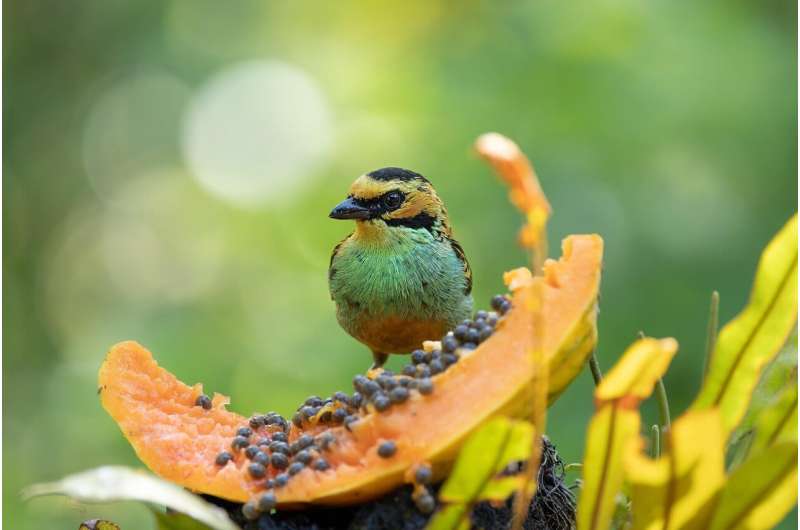Science
Researchers Discover How Birds Use Feathers to Enhance Colors

Birds, known for their vibrant plumage, exhibit an intriguing method for enhancing their colors using hidden black and white feathers. A team from Princeton University led by researcher Rosalyn Price-Waldman has published findings in Science Advances that reveal how these seemingly dull feathers play a crucial role in intensifying the brightness of blue and yellow plumage.
The study highlights a fascinating phenomenon in which colored feathers can appear more vivid when layered over a foundation of either black or white feathers. For instance, birds with blue feathers benefit significantly from a black under-layer, which absorbs light and allows the blue hue to stand out more prominently. This discovery emphasizes the role of sexual selection in avian coloration, a concept first introduced by Charles Darwin. Male birds often display brighter colors to attract mates, thus enhancing their reproductive success.
Mechanics of Color Enhancement
The mechanics behind this color enhancement are rooted in light absorption and reflection. When light passes through the blue feathers, the black layer underneath absorbs wavelengths that do not correspond to blue, allowing the color to “pop.” Conversely, yellow feathers, which derive their shade from carotenoid pigments, are enhanced by a white under-layer. This white foundation reflects light, increasing the brightness of the yellow and contrasting it sharply against other colors.
In their research, Price-Waldman and colleagues primarily focused on tanagers, colorful fruit-eating birds native to Central and South America. Upon discovering this coloration technique in tanagers, the researchers expanded their investigation to other bird families. Remarkably, they found that the use of black and white feathers to amplify color is common across various species, including the vibrant Australian fairy wrens.
Implications and Future Applications
The widespread application of this coloration strategy suggests that birds have been utilizing this method for tens of millions of years, showcasing an evolutionary advantage in their quest for attractive plumage. Understanding how such complex traits evolve in nature not only enhances our knowledge of avian biology but could also inspire advancements in fields such as architecture, art, and fashion, where vibrant colors are desirable.
The implications of this research extend beyond academic interest, encouraging further exploration into the evolutionary processes that shape animal coloration. As scientists continue to unravel the mysteries of bird plumage, the potential for new applications in human design becomes increasingly evident.
More information about this study can be found in the article titled “Hidden white and black feather layers enhance plumage coloration in tanagers and other songbirds,” available in Science Advances (2025), DOI: 10.1126/sciadv.adw5857.
-

 World2 weeks ago
World2 weeks agoCoronation Street’s Shocking Murder Twist Reveals Family Secrets
-

 Entertainment1 week ago
Entertainment1 week agoAndrew Pierce Confirms Departure from ITV’s Good Morning Britain
-

 Entertainment5 months ago
Entertainment5 months agoKate Garraway Sells £2 Million Home Amid Financial Struggles
-

 Entertainment4 months ago
Entertainment4 months agoAnn Ming Reflects on ITV’s ‘I Fought the Law’ Drama
-

 Entertainment1 month ago
Entertainment1 month agoCoronation Street Fans React as Todd Faces Heartbreaking Choice
-

 Health4 months ago
Health4 months agoKatie Price Faces New Health Concerns After Cancer Symptoms Resurface
-

 World1 month ago
World1 month agoBailey Announces Heartbreaking Split from Rebecca After Reunion
-

 Entertainment2 weeks ago
Entertainment2 weeks agoTwo Stars Evicted from I’m A Celebrity Just Days Before Finale
-

 World2 weeks ago
World2 weeks agoKevin Sinfield Exceeds Fundraising Goal Ahead of Final Marathons
-

 Entertainment4 months ago
Entertainment4 months agoCoronation Street’s Carl Webster Faces Trouble with New Affairs
-

 Entertainment4 months ago
Entertainment4 months agoWhere is Tinder Swindler Simon Leviev? Latest Updates Revealed
-

 Entertainment5 months ago
Entertainment5 months agoMarkiplier Addresses AI Controversy During Livestream Response





















